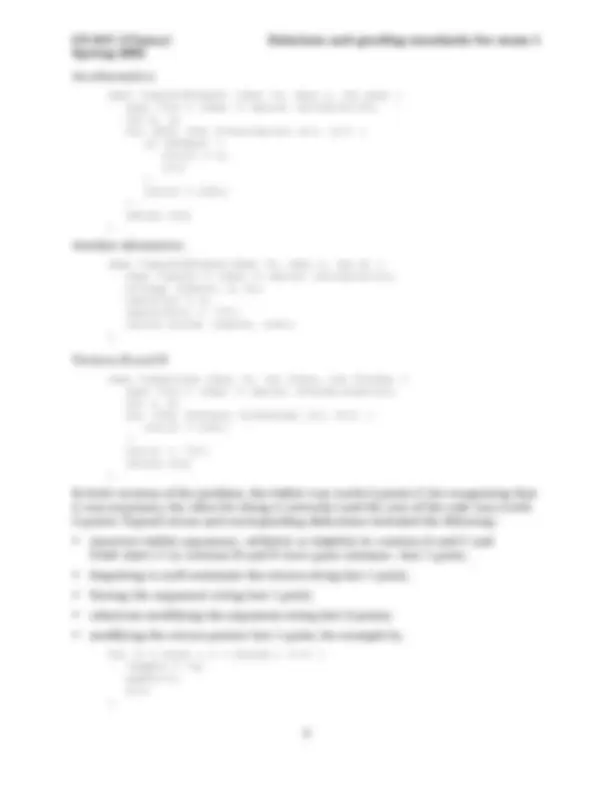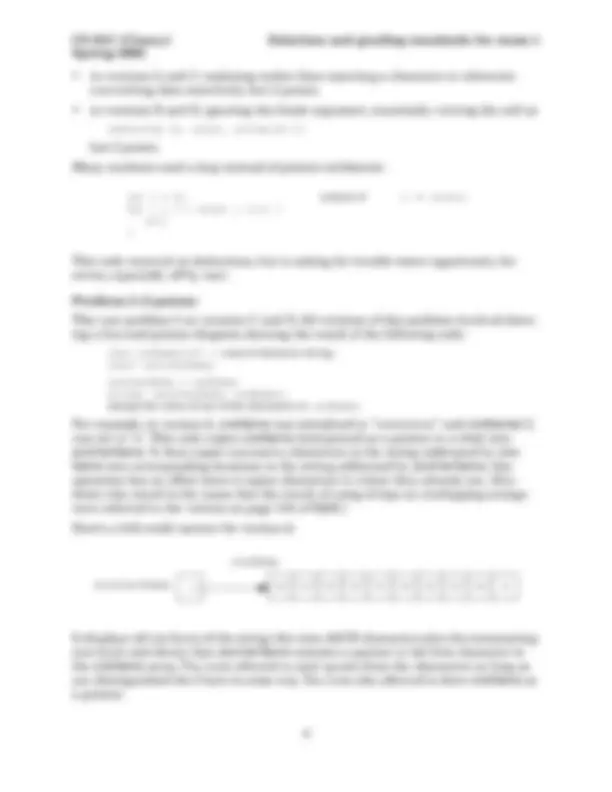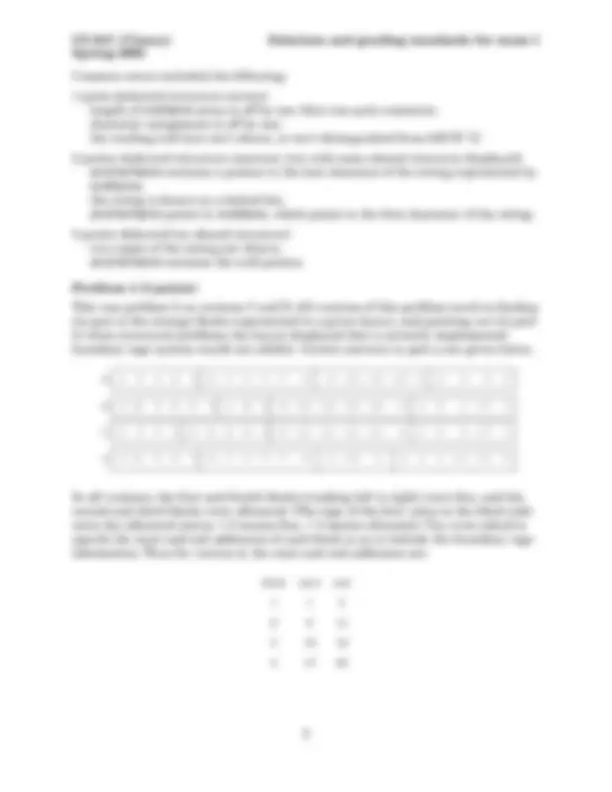





Study with the several resources on Docsity

Earn points by helping other students or get them with a premium plan


Prepare for your exams
Study with the several resources on Docsity

Earn points to download
Earn points by helping other students or get them with a premium plan
Community
Ask the community for help and clear up your study doubts
Discover the best universities in your country according to Docsity users
Free resources
Download our free guides on studying techniques, anxiety management strategies, and thesis advice from Docsity tutors
Main points of this past exam are: Language Program, Program Segment, C Program, Eecs Instructional, HexasrDimal Constant, Printf Format, Functions Declared, Box-And-Pointer Diagram, Storage Layout, Boundary Tags
Typology: Exams
1 / 7

This page cannot be seen from the preview
Don't miss anything!




Spring 2002
Exam information
285 students took the exam. Scores ranged from 3 to 20, with a median of 15 and an average of 14.3. There were 122 scores between 16 and 20, 130 between 11 and 15, 27 between 5.5 and 10, and 6 between 3 and 5. (Were you to receive a grade of 16 on all your midterm exams, 48 on the final exam, plus good grades on homework, quiz- zes, and lab, you would receive an A–; similarly, a test grade of 11 may be projected to a B–.)
There were four versions of the exam, A, B, C, and D. (The version indicator appears at the bottom of the first page.) Versions A and C were similar except for the sequence of the problems. Versions B and D were also similar except for the sequence of the problems.
If you think we made a mistake in grading your exam, describe the mistake in writ- ing and hand the description with the exam to your lab t.a. or to Mike Clancy. We will regrade the entire exam (even if the only error is a mistake in adding up your points).
Solutions and grading standards
Problem 0 (1 point)
You lost 1 point on this problem if you did any of the following:
The reason for this apparent harshness is that exams can get misplaced or come unstapled, and we would like to make sure that every page is identifiable. We also need to know where you will expect to get your exam returned. Finally, we occasion- ally need to know where students were sitting in the class room while the exam was being administered.
Problem 1 (3 points)
This was problem 3 on versions C and D. All versions involved initializing a pointer to an int, printing the result of post-incrementing or post-decrementing it, and then printing it directly. Here, for example, is the code for version A:
ptr = 0x1050; printf ("%x\n", ptr--); printf ("%x\n", ptr);
The first printf prints the result of evaluating ptr– –, which is the value of ptr before the decrementing happens. (Contrast this to – – ptr, a pre-increment operation in which the decrementing is done and then the resulting pointer value is returned.)
Spring 2002
Since ptr is a pointer to an int, the result of incrementing or decrementing is an increase or decrease of 4 in the underlying address. Thus the correct answers are
The 3 points were split as follows:
The most common errors (examples are given for version A) were the following:
Problem 2 (5 points)
This was problem 4 on versions C and D. In versions A and C, you were asked to write a function resultOfInsert that returned the result of inserting a given character into a given string at a given position. In versions B and D, you were to write a func- tion substring that, given a string and two positions, returned the corresponding sub- string. You were not allowed to change the argument string in either case. Here are solutions.
Versions A and C
char *resultOfInsert (char *s, char c, int pos) { char *rtn = (char *) malloc (strlen(s)+2); int k; for (k=0; k<pos; k++) { rtn[k] = s[k]; } rtn[pos] = c; for (k=pos; k<=strlen(s); k++) { rtn[k+1] = s[k]; } return rtn; }
version A version B version C version D 1050 104C
2018 201C
6530 652C
5498 549C
Spring 2002
substring (s, start, strlen(s)–1) lost 2 points.
Many students used a loop instead of pointer arithmetic:
This code received no deductions, but is asking for trouble (more opportunity for errors, especially off by one).
Problem 3 (3 points)
This was problem 5 on versions C and D. All versions of this problem involved draw- ing a box-and-pointer diagram showing the result of the following code:
char oneName[10] = some 9-character string; char* anotherName; anotherName = oneName; strcpy (anotherName, oneName); change the value of one of the characters in oneName;
For example, in version A, oneName was initialized to "xxxxxxxxx" and oneName[1] was set to 'o'. This code copies oneName (interpreted as a pointer to a char) into anotherName. It then copies successive characters in the string addressed by one- Name into corresponding locations in the string addressed by anotherName; this operation has no effect since it copies characters to where they already are. (Stu- dents who noted in the exam that the result of using strcpy on overlapping strings were referred to the version on page 105 of K&R.)
Here’s a full-credit answer for version A:
It displays all ten bytes of the string (the nine ASCII characters plus the terminating zero byte) and shows that anotherName contains a pointer to the first character in the oneName array. You were allowed to omit quotes from the characters as long as you distinguished the 0 byte in some way. You were also allowed to draw oneName as a pointer.
int i = 0; for ( ; i < start ; i++) { s++; }
instead of s += start;
oneName
anotherName
Spring 2002
Common errors included the following:
1 point deducted (structure correct) length of oneName array is off by one (this was quite common); character assignment is off by one; the trailing null byte isn’t shown, or isn’t distinguished from ASCII 'O'.
2 points deducted (structure incorrect, but with some shared structure displayed) anotherName contains a pointer to the last character of the string represented by oneName; the string is drawn as a linked list; anotherName points to oneName, which points to the first character of the string.
3 points deducted (no shared structure) two copies of the string are drawn; anotherName contains the null pointer.
Problem 4 (5 points)
This was problem 2 on versions C and D. All versions of this problem involves finding (in part a) the storage blocks represented in a given layout, and pointing out (in part b) what structural problems the layout displayed that a correctly implemented boundary tags system would not exhibit. Correct answers to part a are given below.
In all versions, the first and fourth blocks (reading left to right) were free, and the second and third blocks were allocated. (The sign of the first value in the block indi- cates the allocated status: > 0 means free, < 0 means allocated.) You were asked to specify the start and end addresses of each block so as to include the boundary tags information. Thus for version A, the start and end addresses are
block start end 1 1 5 2 6 11 3 12 16 4 17 20
A: 3 0 0 -2 3 -4 -7 -7 -7 -7 -4 -3 -13 -13 -13 -3 2 0 0 2
B: 4 16 0 -2 -2 4 -1 -8 -1 -4 -12 -12 -12 -12 -4 3 0 1 -17 3
C: 2 0 0 2 -3 -6 -6 -6 -3 -4 -11 -11 -11 -11 -4 3 0 0 -17 3
D: 3 15 0 -2 3 -4 -7 -7 -7 -7 -4 -1 -13 -1 4 0 1 -17 -17 4
Spring 2002
Problem 3 (3 points)
This was problem 1 in versions C and D. In all versions, it involved loading a register with a character from an array of strings (the same array and the same strings in all versions). A diagram of the storage layout appears below.
A solution first involved getting the correct string address into a register. In versions A and C, you were to access the fourth character of the second string. The address of the second string could be loaded in several ways, for example:
In versions B and D, you were to access the eighth character in the fourth string, so instead of an offset of 4, you would use 12.
Once the proper string address is loaded, you use lb to load one of its characters:
lb $t0,3($t1) in versions A and C lb $t0,7($t1) in versions B and D
You lost 1 point for each error. Examples included the wrong load instruction (mixing up la, lw, and lb), the wrong offset (typically off by one or off by a factor of 4), not enough loads, no offset used, and bad syntax. Offset errors were deducted for each instruction they occurred in.
A surprising number of students coded these accesses as loops, thereby maximizing their chances for making mistakes.
la $t1,names lw $t1,4($t1)
lw $t1,names+4 addi $t1,$0, lw $t1,names($t1)
names (^) 'm'
'c' 'd' 'p'
'i' 'l' 'a' 'a'
'c'
'e'
'y'
'r'
'k' 'a' 'v' 't'
'e' 'n' 'e' 't' 's''o''n' 0